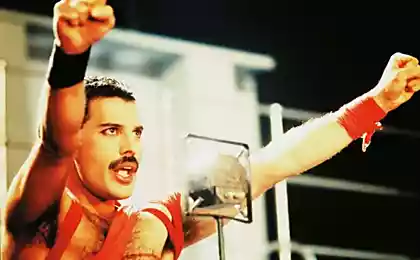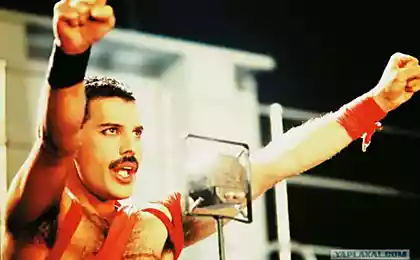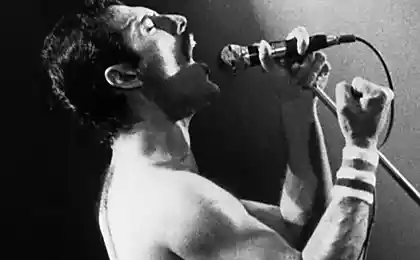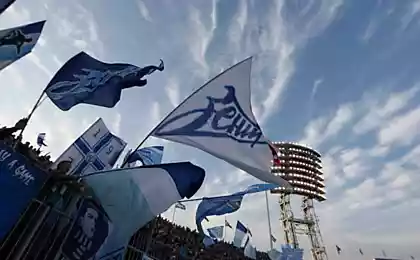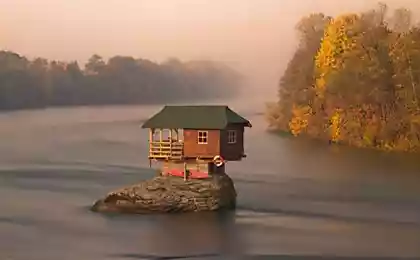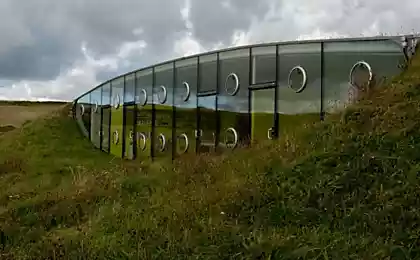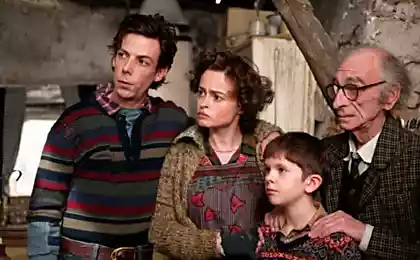1860
House built by Freddie
Mysterious otherworldly offender gets into the dreams of teenagers and kills children. Survive the night meeting with him is possible only one girl who is trying to understand what is happening. Over time, she learns that her and her friends intended spirit of the offender, burned alive by their parents for killing children. When the heroine realizes that the villain will not back down until all avenge his executioners, she calls her boyfriend and offers him a daring plan. After several sleepless nights, she decides to go to sleep - in order to find the maniac and waking up, get him out of the dream world to the human world, where it will be possible to finish. To do this, however, it is necessary that her boyfriend was guarding her and woke up at the right time. His instructions, it ends with the words: "Do what you want ... just do not sleep»

American horror story like a children's horror story about a coffin on wheels. The longer growing genre, the closer to the audience are monsters and maniacs. At first the audience scared monsters from distant lands like Egypt and Transylvania. Then the "favorite" monsters of America became the inhabitants of the provincial backwater and motels in the suburbs. Finally, in the late 1970s maniacs went terrorize peaceful, prosperous suburbs. It seemed closer it was impossible to get close. However, in 1984, directed by Wes Craven sent a coffin on wheels in teenage dreams. His "horror" that has infected many young viewers insomnia, called simply and terribly, "Nightmare on Elm Street».
Wes Craven began his professional life to teaching at the college, but to teach the young guys literature he quickly got bored. Mount for them adult movies Craven was much more interesting, and the beginning of 1970 he spent in the industry as an editor and writer.
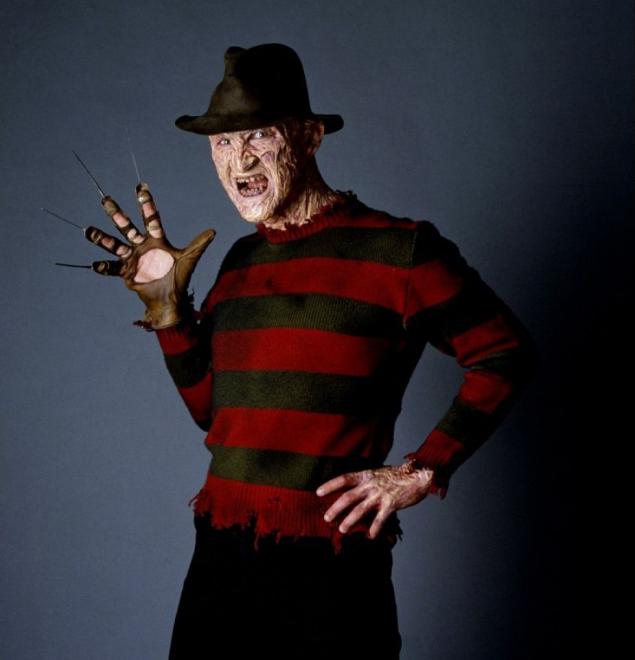
Then his friend, producer Sean Cunningham (future director of "Friday the 13th"), has drawn in Craven cheerful business, offered him work on low-budget horror. As a child, Wes, grew up in an orthodox Baptist family, was not allowed into a movie, and because he had no idea what are the horror and how to write scripts for them. When he confessed to Cunningham, he said that Craven has to come up with a story that would have scared his parents-fundamentalists. Thus was born "The Last House on the Left" (1972) - uncut and screenwriting debut Craven in genre cinema.
"Last House" was a good idea at the box office (for the film with a tiny budget), and the next ten years Craven spent alternating work in the genre, and adult movies. Then in 1982 he took komiksno-superhero film "Swamp Thing", that did not really work ... And in my life Craven started a black stripe. After a year of unemployment, he lost his home and his wife and hooked on coke. When the director finally got out of the Depression, he began work on a new horrornym script that was supposed to return it to the profession.
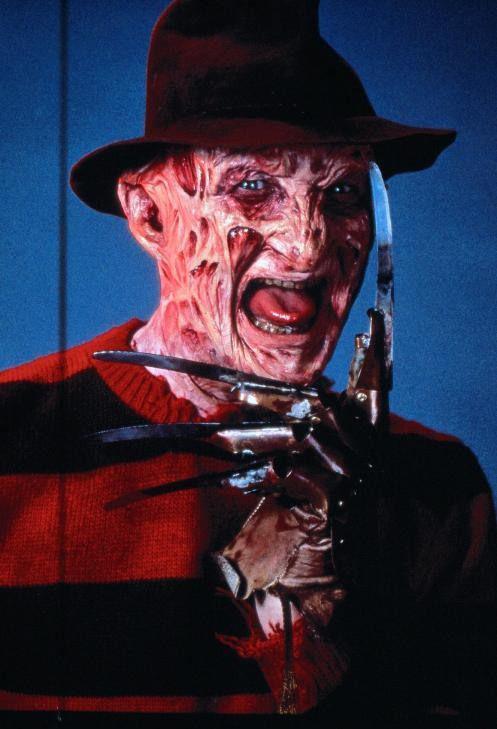
When talking about the film, the main effect of which develops in a dream, always suspect that the writer learned the story in their own nightmares. But the "Nightmare on Elm Street" was coined in reality. Craven inspired article in the newspaper LA Times about a young man from a family of immigrants from Cambodia, who suddenly said relatives: it pursues a nightmare and he's afraid that if asleep again, then dies. A few days later, he really had no sleep, and when asleep, the middle of the night roared and died without waking up.
Surprisingly, in such cases, which are periodically befall with people from Cambodia, Laos and Thailand, there is a scientific explanation. Some people from this region have a genetic disorder that can disrupt the heart suddenly a young and seemingly healthy person and slay him on the spot. This phenomenon is known from time immemorial, and it is generally believed that the young men killed otherworldly monsters. There are, for example, the legend that such a death - "merit" of the spirit of jealous women and men because of nationality, where the legend There is, sometimes go to bed in women's clothing to deceive the ghost.
Clearly, for the legend of the bloodthirsty Craven vengeful spirit was much more useful than arguments about genes and disorders of the heart. Combining eastern legend with the world of youth horror, film director came up with a story about a maniac ghost, who, after the death at the hands of angry townspeople avenges his killers, destroying in a dream of their children. In this case, none of the adults do not understand what is really going on. When teenagers refuse to sleep, their parents think it is just teenage whim.
When Craven told his story Cunningham, who said that a maniac living in nightmares - is an idea for a children's fairy tale, and not for the teenage horror. The creator of "Friday the 13th" believed that young people can scare a "real" killers. Although it may possess supernatural powers. Craven, however, was convinced that came upon a great idea, and he continued to develop it, although no one had promised him to pay for it.
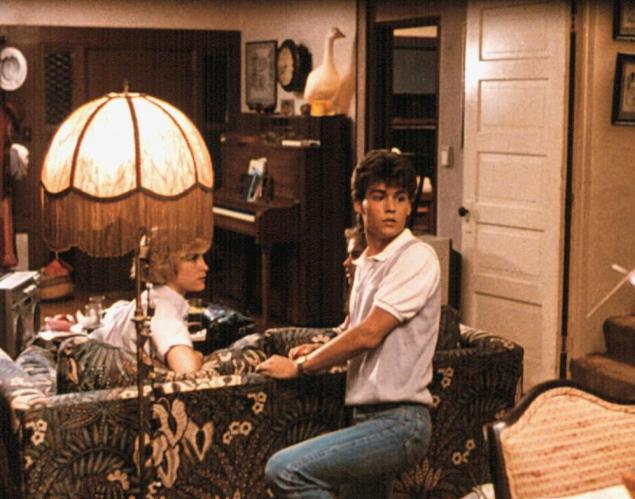
By the time the youth horror was already a well-established genre, and it was easy to invent Craven teens who die at the hands of a maniac and trying to resist him. Was much more difficult to devise a truly terrible killer. Instead of relying on his own imagination, Craven has designed the villain of the details, which, according to psychological research, causes people the greatest horror or disgust. In particular, the maniac got a glove with knives, because in each of us lives a primitive fear of animal claws, and his sweater was painted in red and green, because it is a combination of the strongest irritates human eyes. The name "Freddy Krueger" character inherited from a bully who taunted Wes in childhood. Craven previously used this name in "the last house on the left", where one of the villains called Fred, and another - Krug.
The tradition of the genre dictates that the villain wearing a frightening mask and kill silently, but Craven such maniacs were not interested. The director wanted to Kruger was a full-fledged character with cues and facial expressions, and not just "evil incarnate." Therefore, a person maniac was not hidden under the mask and disfigured by fire (parents characters in the film burned alive killer).
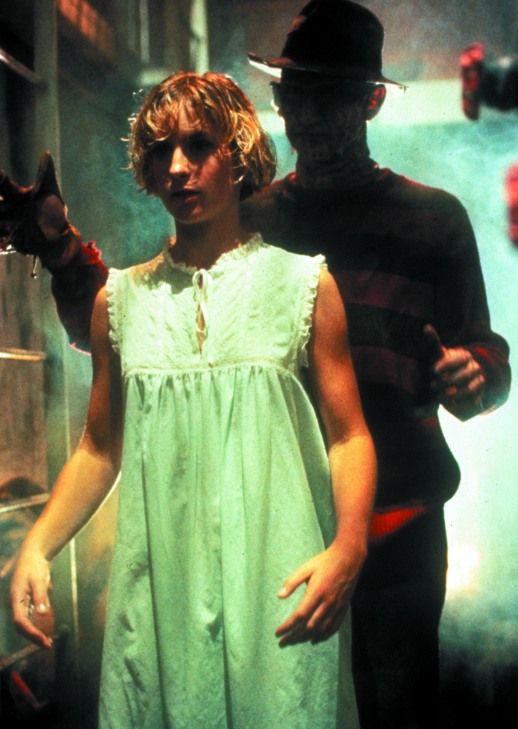
If this tradition Craven violated, then the other, he followed to the last point. Genre demanded a symbolic link older adults and behavior of young heroes with the threat of their lives, and the picture was filled with grim Freudian symbolism. So, a friend of the main character in the beginning of the film die shortly after making love, and the scene of the massacre of her resembles a rape. In turn, the main character, despite the presence of an attractive boyfriend remained a virgin until the very end of the film. And her endurance, willpower and presence of mind allowed her to defeat the maniac who seemingly was impossible to win (how to kill someone who is dead and who commands deadly nightmare?). Thus, the picture was both feminist and conservative. That, in general, typical ideologically dual Hollywood of the 1980s.
As predicted by Cunningham, Craven's first attempts to sell the script "Nightmare" failed. Studio, engaged in horror, thought the idea of a children's tape too, but, for example, Walt Disney offered to rewrite the script so that it really became a scary story for kids. Craven proposal indignantly rejected, but the best at it for a long time was not. At some point, the script became interested in Paramount, but she did not buy it because it has already produced the similar to the basic idea of a fantastic horror "Dreamscape" (1984).
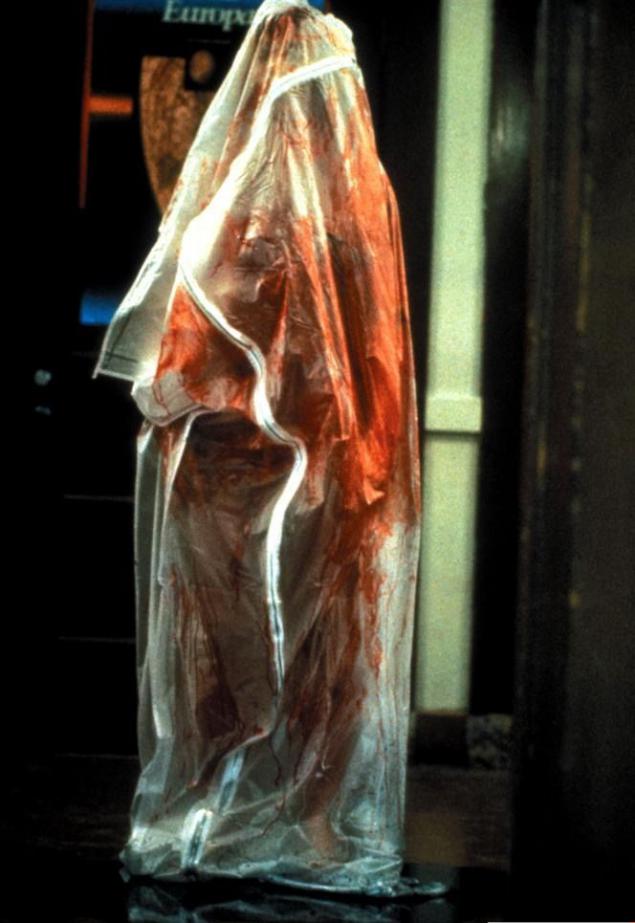
Finally, the scenario of "Nightmare" was in the hands of Bob Neck, head of the small independent distribution company New Line Cinema, and he was carried away in earnest text. Unlike colleagues Shea agreed with Craven that the horror of the killer of dreams can scare many, because all viewers - both adults and children - have seen terrible nightmares and fear that they will come true in reality. In addition, the neck does not have much choice. His company has just started producing movies, teetered on the brink of bankruptcy and could only save her low-budget hit. Scripts that are known to not grow on trees.
Since the own funds at New Line Cinema almost was not, "Nightmare" paid for by private investors - those who stayed to the end and not abandoned the project midway (common in such situations). Due to the unstable funding tape visited the week, when the crew did not receive a salary. As a result, half the price paid for the painting of Yugoslav origin producer George Zechevich, which is later claimed Shay, invested in the movie to make his mistress star. Financing "Nightmare", however, was for him a purely business project. The picture cost $ 1, $ 1 million - and a half times more than the budget, which was been drawn up at the beginning of work on the "Nightmare".
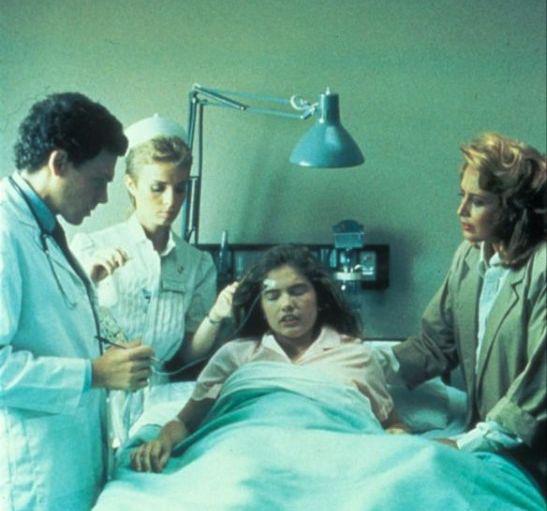
To "Nightmare" villains in the youth horror movies often played the stunt, and choosing an actor for the lead role, Craven faced with the fact that no one comes to the sample did not know how to portray a bloodthirsty maniac. Like a cat Leopold, the actors could not adequately be angry and go into a sadistic way.
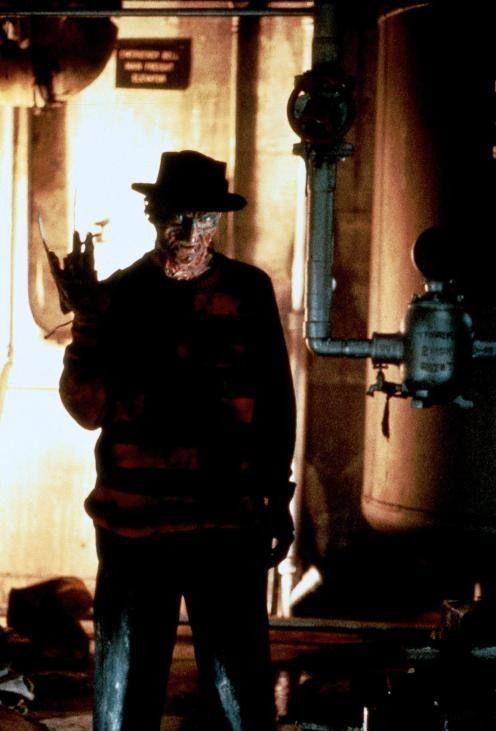
Light at the end of the tunnel began to dawn only when the audition was Robert Englund, a decade earlier to claim the role of Han Solo in "Star Wars." Known for playing the kind-hearted stranger Willie in a fantastic mini-series «V» (actor looking for a new job to hold between filming a mini-series and the subsequent television series of the same name full), Englund was not outwardly look like a murderer. He usually played "nerds." However, his face was something strange and frightening, and he was ready to play a maniac not holding back on all cylinders. Therefore Craven gave him the role, though hoping to find someone bigger, more terrible and more terrible face. Until Englund director observed the Briton David Warner of horror "The Omen."
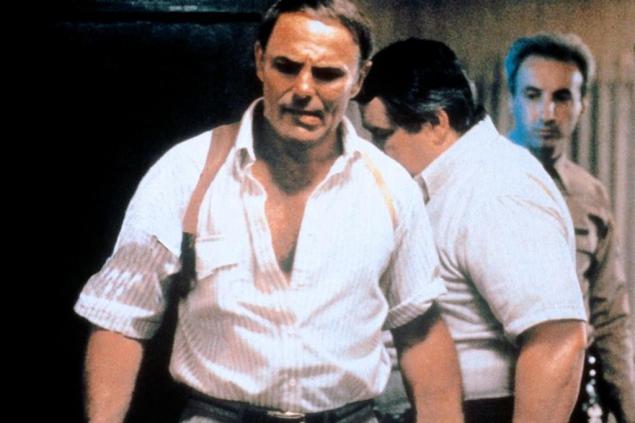
Among the films of the horror genre is less in need of stars. These films are often only benefit from the "non-illuminated" entities in which the audience sees the characters, not the actors. But the genre genre and Finance Finance - to convince at least someone to invest in "Nightmare", neck had to demonstrate that in the picture ready to play famous people. Therefore Craven gave the role of mother of the main character Ronnie Blakely, nominee "Oscar" for the Robert Altman film "Nashville" and ex-wife of German director Wim Wenders. In turn, the father of the main character, a police Lieutenant Thompson, played by John Saxon from the movie with Bruce Lee "Enter the Dragon" and a number of other popular US films and TV series.
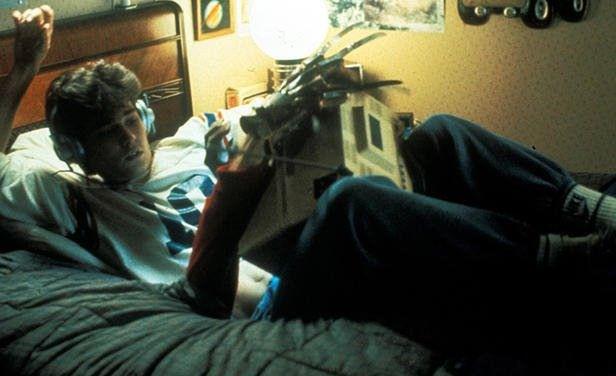
Selecting a quota of celebrities, Craven on basic, teen role hired aspiring actors and newcomers. The most popular of them later became Johnny Depp, who at that time was a rock musician (when his musical career has not worked, his friend Nicolas Cage advised Depp to try himself in Hollywood). Although the "Nightmare" was his first appearance on the screen, Craven entrusted him a key role handsome Glen, boyfriend of the heroine.
Interestingly, Depp came to the audition with his friend Jackie Earle Haley. He did not get the role in the film, but many years later played Freddy Krueger in the remake of "A Nightmare" 2010. There are also matching!
To make a final decision about the role, Craven consulted with his teenage daughter and her friend. When he laid out photos of potential Glen, the girls immediately pointed to Depp. Although Craven did not like that guy looks unwashed, pale and sickly and that he smokes like a chimney, the director was forced to agree with the experts on youth appeal. Prior to hiring Depp's main contender for the role was Charlie Sheen, the future hero of the film by Oliver Stone, but its services are too expensive cost (since it was not just a novice actor and son of the famous actor Martin Sheen).
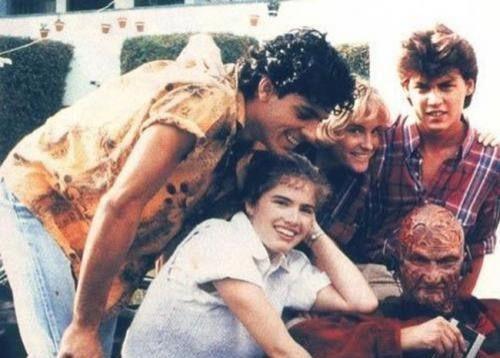
While the role of director Glenn picked charming guy, the main character Nancy Thompson, in the opinion of Craven, was to play a girl who looked like an ordinary high school student, not the model. That is young, fresh, but not too well-groomed and "symmetric". Auditioned for the role were open, and they involved two hundred actresses, including such future stars as Demi Moore, Courteney Cox and Jennifer Grey. But Craven chose not to someone of them, and Heather Langenkamp - debutante, who came from an influential family (her father was a "bump" in the American Energy), studied at Stanford, but suddenly decided to break into the movie screen. And shot - "Nightmare" for a short time made her the star of the genre.

Unlike Langenkamp, Hsu Garcia - who plays Rhoda boyfriend dies in the beginning of the movie girlfriend Nancy named Tina - was homeless at the time came from a family of Cuban refugees. He disguised himself as an Italian, was shot under the pseudonym Nick Corrie, and starred stoned. In particular, in the scenes where Rob is behind bars. Tina portrayed Amanda Weiss, previously played a small role in the teen comedy "Thoughtless time in the" Ridgemont High. '" She later starred in a first season of "Highlander".
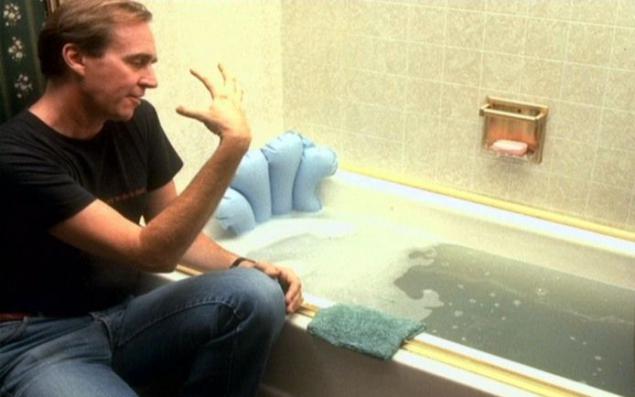
The film was developed in the fictional town of Springwood, Ohio, but shooting "The Nightmare" were entirely in California, in June-July 1984. For reasons of economy grotesque scenes of death and Tina Glenn starred in the same scenery that could turn upside down (for those portions where Tina crawling on the ceiling and where the bed is cast from the blood stream). Director and cameraman were fixed on the ceiling in the seat of a racing car with a lot of seat belts.
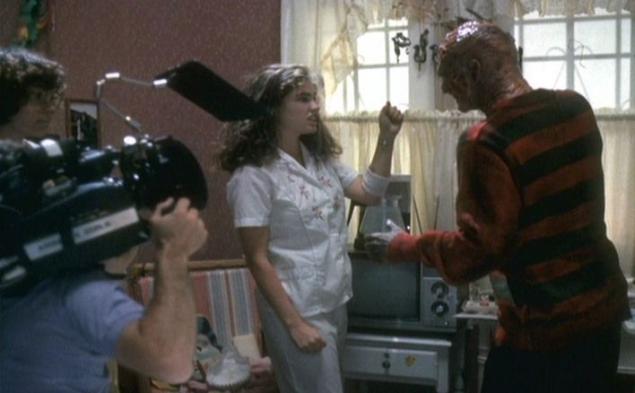
Just on the set was shed almost two cubic meters of blood. Not all of it was artificial. For example, a glove with blades worn by Freddie hurt anyone who wore it (whether or stunt Englund), because it could not be on hand to compress a fist, but people do it almost by reflex. To keep cuts to a minimum in most scenes "Freddie" go to the glove, the blades of which were blunted. Sharp knives appear on the site only when the villain had to be something in the frame cut or cut.
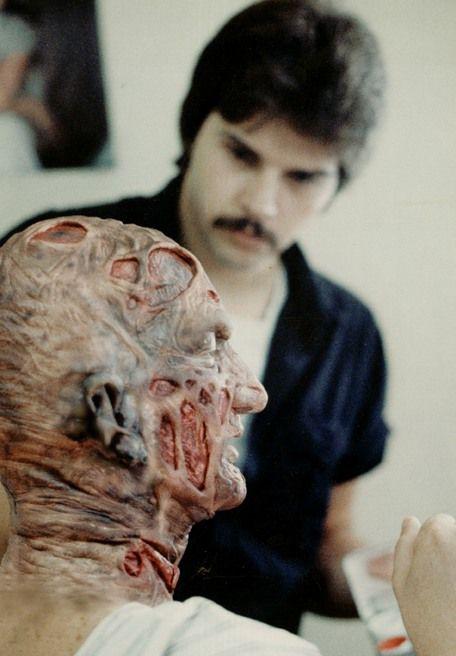
Grim as Freddie was initially test for Englund. Makeup artist Dave Miller hours and days "conjured" over the actor before came up with makeup, which gave the director, and Englund used this time to mentally "pump up" themselves and try to feel pissed at the world maniac.
In the scenario, which Craven started shooting, Kruger has been called "the rapist of children." But as at that time in California investigated several high-profile cases of this kind, the director decided to distance himself from them now and declare Kruger "killer of children." Is concerned, however, only the events that preceded the massacre of the villain. After the death of Freddie teens killed in both versions of the script.
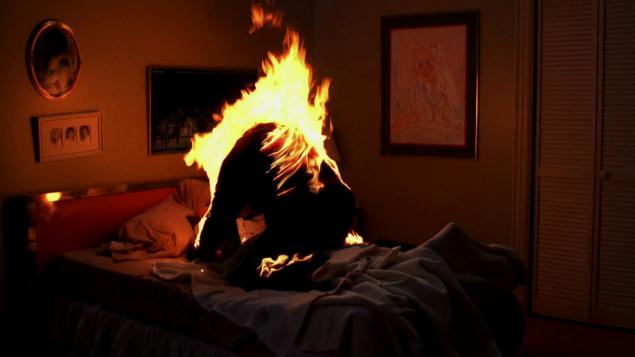
Much more significant change was reshaping the final scene. Craven wanted to tape ended on a positive note: Nancy wins Freddie wakes up and discovers that the whole story was just a nightmare and that her friends are alive and well. Robert Shea, however, insisted that the painting was completed return Kruger - just as has been completed "Friday the 13th" and some other well-known horror. Craven vehemently objected because he did not want to turn "Nightmare" in the sequel. Although he eventually surrendered to the producer, he refused to work on the sequel tape, when it became a hit.
It happened in November 1984 - Craven and his men were in a hurry to catch to release the film in the Halloween season. "A Nightmare on Elm Street" was released in rent November 9th, and he earned an impressive $ 25 million in the final budget of 1, 8 million (excluding the production budget and other expenses). Most surprising was the enthusiasm of critics, usually cold horror host youth. However, the picture was really more of a typical horror - deeper, quirky, inventive and brighter. Special commendation awarded Nancy and Freddy - facing each other opponents who were much more interesting than the usual girls and freaks of Hollywood slasher.

The success of "Nightmare" was so great that he saved the New Line Cinema from bankruptcy and gave her the nickname "House built by Freddie." The next film cycle came in 1985, and "A Nightmare on Elm Street" soon became one of the key western horror movie series. Freddy Krueger became a favorite of the audience - disgusting, but also charming scoundrel with a grim sense of humor who loves to play with the victims and mock them in word and in deed.

American horror story like a children's horror story about a coffin on wheels. The longer growing genre, the closer to the audience are monsters and maniacs. At first the audience scared monsters from distant lands like Egypt and Transylvania. Then the "favorite" monsters of America became the inhabitants of the provincial backwater and motels in the suburbs. Finally, in the late 1970s maniacs went terrorize peaceful, prosperous suburbs. It seemed closer it was impossible to get close. However, in 1984, directed by Wes Craven sent a coffin on wheels in teenage dreams. His "horror" that has infected many young viewers insomnia, called simply and terribly, "Nightmare on Elm Street».
Wes Craven began his professional life to teaching at the college, but to teach the young guys literature he quickly got bored. Mount for them adult movies Craven was much more interesting, and the beginning of 1970 he spent in the industry as an editor and writer.

Then his friend, producer Sean Cunningham (future director of "Friday the 13th"), has drawn in Craven cheerful business, offered him work on low-budget horror. As a child, Wes, grew up in an orthodox Baptist family, was not allowed into a movie, and because he had no idea what are the horror and how to write scripts for them. When he confessed to Cunningham, he said that Craven has to come up with a story that would have scared his parents-fundamentalists. Thus was born "The Last House on the Left" (1972) - uncut and screenwriting debut Craven in genre cinema.
"Last House" was a good idea at the box office (for the film with a tiny budget), and the next ten years Craven spent alternating work in the genre, and adult movies. Then in 1982 he took komiksno-superhero film "Swamp Thing", that did not really work ... And in my life Craven started a black stripe. After a year of unemployment, he lost his home and his wife and hooked on coke. When the director finally got out of the Depression, he began work on a new horrornym script that was supposed to return it to the profession.

When talking about the film, the main effect of which develops in a dream, always suspect that the writer learned the story in their own nightmares. But the "Nightmare on Elm Street" was coined in reality. Craven inspired article in the newspaper LA Times about a young man from a family of immigrants from Cambodia, who suddenly said relatives: it pursues a nightmare and he's afraid that if asleep again, then dies. A few days later, he really had no sleep, and when asleep, the middle of the night roared and died without waking up.
Surprisingly, in such cases, which are periodically befall with people from Cambodia, Laos and Thailand, there is a scientific explanation. Some people from this region have a genetic disorder that can disrupt the heart suddenly a young and seemingly healthy person and slay him on the spot. This phenomenon is known from time immemorial, and it is generally believed that the young men killed otherworldly monsters. There are, for example, the legend that such a death - "merit" of the spirit of jealous women and men because of nationality, where the legend There is, sometimes go to bed in women's clothing to deceive the ghost.
Clearly, for the legend of the bloodthirsty Craven vengeful spirit was much more useful than arguments about genes and disorders of the heart. Combining eastern legend with the world of youth horror, film director came up with a story about a maniac ghost, who, after the death at the hands of angry townspeople avenges his killers, destroying in a dream of their children. In this case, none of the adults do not understand what is really going on. When teenagers refuse to sleep, their parents think it is just teenage whim.
When Craven told his story Cunningham, who said that a maniac living in nightmares - is an idea for a children's fairy tale, and not for the teenage horror. The creator of "Friday the 13th" believed that young people can scare a "real" killers. Although it may possess supernatural powers. Craven, however, was convinced that came upon a great idea, and he continued to develop it, although no one had promised him to pay for it.

By the time the youth horror was already a well-established genre, and it was easy to invent Craven teens who die at the hands of a maniac and trying to resist him. Was much more difficult to devise a truly terrible killer. Instead of relying on his own imagination, Craven has designed the villain of the details, which, according to psychological research, causes people the greatest horror or disgust. In particular, the maniac got a glove with knives, because in each of us lives a primitive fear of animal claws, and his sweater was painted in red and green, because it is a combination of the strongest irritates human eyes. The name "Freddy Krueger" character inherited from a bully who taunted Wes in childhood. Craven previously used this name in "the last house on the left", where one of the villains called Fred, and another - Krug.
The tradition of the genre dictates that the villain wearing a frightening mask and kill silently, but Craven such maniacs were not interested. The director wanted to Kruger was a full-fledged character with cues and facial expressions, and not just "evil incarnate." Therefore, a person maniac was not hidden under the mask and disfigured by fire (parents characters in the film burned alive killer).

If this tradition Craven violated, then the other, he followed to the last point. Genre demanded a symbolic link older adults and behavior of young heroes with the threat of their lives, and the picture was filled with grim Freudian symbolism. So, a friend of the main character in the beginning of the film die shortly after making love, and the scene of the massacre of her resembles a rape. In turn, the main character, despite the presence of an attractive boyfriend remained a virgin until the very end of the film. And her endurance, willpower and presence of mind allowed her to defeat the maniac who seemingly was impossible to win (how to kill someone who is dead and who commands deadly nightmare?). Thus, the picture was both feminist and conservative. That, in general, typical ideologically dual Hollywood of the 1980s.
As predicted by Cunningham, Craven's first attempts to sell the script "Nightmare" failed. Studio, engaged in horror, thought the idea of a children's tape too, but, for example, Walt Disney offered to rewrite the script so that it really became a scary story for kids. Craven proposal indignantly rejected, but the best at it for a long time was not. At some point, the script became interested in Paramount, but she did not buy it because it has already produced the similar to the basic idea of a fantastic horror "Dreamscape" (1984).

Finally, the scenario of "Nightmare" was in the hands of Bob Neck, head of the small independent distribution company New Line Cinema, and he was carried away in earnest text. Unlike colleagues Shea agreed with Craven that the horror of the killer of dreams can scare many, because all viewers - both adults and children - have seen terrible nightmares and fear that they will come true in reality. In addition, the neck does not have much choice. His company has just started producing movies, teetered on the brink of bankruptcy and could only save her low-budget hit. Scripts that are known to not grow on trees.
Since the own funds at New Line Cinema almost was not, "Nightmare" paid for by private investors - those who stayed to the end and not abandoned the project midway (common in such situations). Due to the unstable funding tape visited the week, when the crew did not receive a salary. As a result, half the price paid for the painting of Yugoslav origin producer George Zechevich, which is later claimed Shay, invested in the movie to make his mistress star. Financing "Nightmare", however, was for him a purely business project. The picture cost $ 1, $ 1 million - and a half times more than the budget, which was been drawn up at the beginning of work on the "Nightmare".

To "Nightmare" villains in the youth horror movies often played the stunt, and choosing an actor for the lead role, Craven faced with the fact that no one comes to the sample did not know how to portray a bloodthirsty maniac. Like a cat Leopold, the actors could not adequately be angry and go into a sadistic way.

Light at the end of the tunnel began to dawn only when the audition was Robert Englund, a decade earlier to claim the role of Han Solo in "Star Wars." Known for playing the kind-hearted stranger Willie in a fantastic mini-series «V» (actor looking for a new job to hold between filming a mini-series and the subsequent television series of the same name full), Englund was not outwardly look like a murderer. He usually played "nerds." However, his face was something strange and frightening, and he was ready to play a maniac not holding back on all cylinders. Therefore Craven gave him the role, though hoping to find someone bigger, more terrible and more terrible face. Until Englund director observed the Briton David Warner of horror "The Omen."

Among the films of the horror genre is less in need of stars. These films are often only benefit from the "non-illuminated" entities in which the audience sees the characters, not the actors. But the genre genre and Finance Finance - to convince at least someone to invest in "Nightmare", neck had to demonstrate that in the picture ready to play famous people. Therefore Craven gave the role of mother of the main character Ronnie Blakely, nominee "Oscar" for the Robert Altman film "Nashville" and ex-wife of German director Wim Wenders. In turn, the father of the main character, a police Lieutenant Thompson, played by John Saxon from the movie with Bruce Lee "Enter the Dragon" and a number of other popular US films and TV series.

Selecting a quota of celebrities, Craven on basic, teen role hired aspiring actors and newcomers. The most popular of them later became Johnny Depp, who at that time was a rock musician (when his musical career has not worked, his friend Nicolas Cage advised Depp to try himself in Hollywood). Although the "Nightmare" was his first appearance on the screen, Craven entrusted him a key role handsome Glen, boyfriend of the heroine.
Interestingly, Depp came to the audition with his friend Jackie Earle Haley. He did not get the role in the film, but many years later played Freddy Krueger in the remake of "A Nightmare" 2010. There are also matching!
To make a final decision about the role, Craven consulted with his teenage daughter and her friend. When he laid out photos of potential Glen, the girls immediately pointed to Depp. Although Craven did not like that guy looks unwashed, pale and sickly and that he smokes like a chimney, the director was forced to agree with the experts on youth appeal. Prior to hiring Depp's main contender for the role was Charlie Sheen, the future hero of the film by Oliver Stone, but its services are too expensive cost (since it was not just a novice actor and son of the famous actor Martin Sheen).

While the role of director Glenn picked charming guy, the main character Nancy Thompson, in the opinion of Craven, was to play a girl who looked like an ordinary high school student, not the model. That is young, fresh, but not too well-groomed and "symmetric". Auditioned for the role were open, and they involved two hundred actresses, including such future stars as Demi Moore, Courteney Cox and Jennifer Grey. But Craven chose not to someone of them, and Heather Langenkamp - debutante, who came from an influential family (her father was a "bump" in the American Energy), studied at Stanford, but suddenly decided to break into the movie screen. And shot - "Nightmare" for a short time made her the star of the genre.

Unlike Langenkamp, Hsu Garcia - who plays Rhoda boyfriend dies in the beginning of the movie girlfriend Nancy named Tina - was homeless at the time came from a family of Cuban refugees. He disguised himself as an Italian, was shot under the pseudonym Nick Corrie, and starred stoned. In particular, in the scenes where Rob is behind bars. Tina portrayed Amanda Weiss, previously played a small role in the teen comedy "Thoughtless time in the" Ridgemont High. '" She later starred in a first season of "Highlander".

The film was developed in the fictional town of Springwood, Ohio, but shooting "The Nightmare" were entirely in California, in June-July 1984. For reasons of economy grotesque scenes of death and Tina Glenn starred in the same scenery that could turn upside down (for those portions where Tina crawling on the ceiling and where the bed is cast from the blood stream). Director and cameraman were fixed on the ceiling in the seat of a racing car with a lot of seat belts.

Just on the set was shed almost two cubic meters of blood. Not all of it was artificial. For example, a glove with blades worn by Freddie hurt anyone who wore it (whether or stunt Englund), because it could not be on hand to compress a fist, but people do it almost by reflex. To keep cuts to a minimum in most scenes "Freddie" go to the glove, the blades of which were blunted. Sharp knives appear on the site only when the villain had to be something in the frame cut or cut.

Grim as Freddie was initially test for Englund. Makeup artist Dave Miller hours and days "conjured" over the actor before came up with makeup, which gave the director, and Englund used this time to mentally "pump up" themselves and try to feel pissed at the world maniac.
In the scenario, which Craven started shooting, Kruger has been called "the rapist of children." But as at that time in California investigated several high-profile cases of this kind, the director decided to distance himself from them now and declare Kruger "killer of children." Is concerned, however, only the events that preceded the massacre of the villain. After the death of Freddie teens killed in both versions of the script.

Much more significant change was reshaping the final scene. Craven wanted to tape ended on a positive note: Nancy wins Freddie wakes up and discovers that the whole story was just a nightmare and that her friends are alive and well. Robert Shea, however, insisted that the painting was completed return Kruger - just as has been completed "Friday the 13th" and some other well-known horror. Craven vehemently objected because he did not want to turn "Nightmare" in the sequel. Although he eventually surrendered to the producer, he refused to work on the sequel tape, when it became a hit.
It happened in November 1984 - Craven and his men were in a hurry to catch to release the film in the Halloween season. "A Nightmare on Elm Street" was released in rent November 9th, and he earned an impressive $ 25 million in the final budget of 1, 8 million (excluding the production budget and other expenses). Most surprising was the enthusiasm of critics, usually cold horror host youth. However, the picture was really more of a typical horror - deeper, quirky, inventive and brighter. Special commendation awarded Nancy and Freddy - facing each other opponents who were much more interesting than the usual girls and freaks of Hollywood slasher.

The success of "Nightmare" was so great that he saved the New Line Cinema from bankruptcy and gave her the nickname "House built by Freddie." The next film cycle came in 1985, and "A Nightmare on Elm Street" soon became one of the key western horror movie series. Freddy Krueger became a favorite of the audience - disgusting, but also charming scoundrel with a grim sense of humor who loves to play with the victims and mock them in word and in deed.


